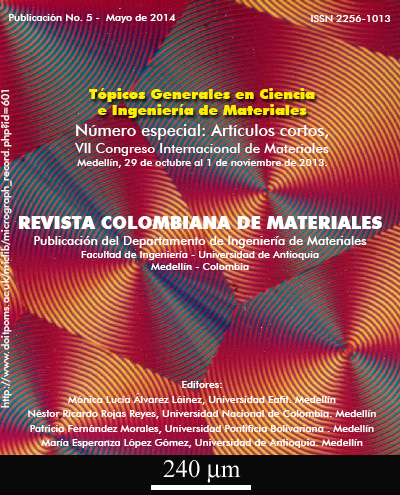.
DOI:
https://doi.org/10.17533/udea.rcm.19719Palavras-chave:
Hipertermia, Nanopartículas magnéticas, BiomaterialesResumo
.
Downloads
Referências
American Cancer Society. “Cancer Facts & Figures 2011”. Atlanta: American Cancer Society; 2011.
Mercade,T.M.;Pascual, F. J.“Comprender el cáncer”. Editorial AMAT, 2009.
Timko, M.et al.“Magnetic properties and heating effect in bacterial magnetic nanoparticles”.Journal of Magnetism and Magnetic Materials, vol. 321, no 10, p.p.1521-1524,2009. DOI: https://doi.org/10.1016/j.jmmm.2009.02.077
Ito, A. et al.“Medical application of functionalized magnetic nanoparticles”.Journal of bioscienceand bioengineering, vol. 100, no 1, p.p.1-11, 2005. DOI: https://doi.org/10.1263/jbb.100.1
Hans-Eckhardt Schaefer, “Nanoscience: the science of the small in physics, engineering, chemistry, biology and medicine”, Springer, 2010. DOI: https://doi.org/10.1007/978-3-642-10559-3
J. Li et al.“Cation distribution depedence of magnetic properties of sol-gel prepared MnFe2O4 spinel ferrite nanoparticles” J. Magn. Magn. Matter. 322, p.p. 3396-3400, 2010. DOI: https://doi.org/10.1016/j.jmmm.2010.06.035
Rahaman, M. N.“Ceramic processing”. CRC Press, 2007.
Deganello, F. et al.“Citrate-nitrate autocombustion synthesis of perovskite-type nanopowders: A systematic approach”. Journal of the European Ceramic Society. 29, p.p.439-450,2009. DOI: https://doi.org/10.1016/j.jeurceramsoc.2008.06.012
Medeiros, S. F. et al. “Stimuli-responsive magnetic particles for biomedical applications”.International journal of pharmaceutics, vol. 403, no 1, p.p.139-161, 2011. DOI: https://doi.org/10.1016/j.ijpharm.2010.10.011
Warrel, R. P. “Gallium nitrate for the treatment of bone metastases”.Cancer, vol. 80, no S8, p. 1680-1685, 1997. DOI: https://doi.org/10.1002/(SICI)1097-0142(19971015)80:8+<1680::AID-CNCR19>3.3.CO;2-L
Verron, E. et al.“Molecular effects of gallium on osteoclastic differentiation of mouse and human monocytes”. BiochemicalPharmacology, 83.5, p.p.671-679, 2012. DOI: https://doi.org/10.1016/j.bcp.2011.12.015
Prado Loaiza J. E. “Correlación entre las propiedades magnéticas y los parámetros morfológicos y estructurales de nanopartículas de Mn0.5Zn0.5Fe2O4. Universidad del Valle. Facultad de Ciencias Naturales y Exactas. Programa de Posgrado en Física. Tesis de Maestría en Ciencias Física.
SharmaK.at al. “Low temperature Raman and high field 57Fe Mossbauer study of polycrystalline GaFeO3”. J. Phys.: Condens. Matter 22,146005, 6p.,2010. DOI: https://doi.org/10.1088/0953-8984/22/14/146005
Roy A. et al.“Electronic structures, born effective charges and spontaneous polarization in magnetoelectric gallium ferrite”. Departament of Materials Science & Engineering, Indian Institute of Technology. Kanpur –208016, India.
Mukherjee S. et al.“Composition dependence ofstructural parameters and properties of gallium ferrite”. Indian Institute of Technology Kanpur, Kanpur 208016, India.
Dweck J. “Ferromagnetic resonance in the highly anisotropic ferrimagnet gallium iron oxide”. Phys. Rev. Volume 168, Number 2, 1968. DOI: https://doi.org/10.1103/PhysRev.168.602
Downloads
Publicado
Como Citar
Edição
Seção
Licença
Copyright (c) 2014 Revista Colombiana de Materiales

Este trabalho está licenciado sob uma licença Creative Commons Attribution-NonCommercial-ShareAlike 4.0 International License.








